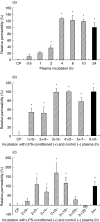Modulation of endothelial monolayer permeability induced by plasma obtained from lipopolysaccharide-stimulated whole blood
- PMID: 16634811
- PMCID: PMC1809663
- DOI: 10.1111/j.1365-2249.2006.03074.x
Modulation of endothelial monolayer permeability induced by plasma obtained from lipopolysaccharide-stimulated whole blood
Abstract
The aim of this study was to elucidate the time course of the permeability response of endothelial monolayers after exposure to plasma obtained from lipopolysaccharide (LPS)-treated human whole blood; to investigate the role of apoptosis in monolayer permeability, and to inhibit the permeability increase, particularly after addition of the plasma stimulus. Human umbilical vein endothelial cells (HUVEC) were cultured on semiporous membranes and the permeability for albumin was measured after exposure, according to different schedules, to LPS-conditioned plasma. Apoptotic HUVEC were measured by both flow cytometry and ELISA. A variety of agents, including antibodies against cytokines, inhibitors of NF-kappaB, and a caspase inhibitor, were added to HUVEC, either prior to or after the stimulus. A maximum increase of the permeability was achieved after 4-6 h of exposure to LPS-conditioned plasma. This response was not accompanied by an increase in the number of apoptotic HUVEC. Administration of antibodies against both Tumour Necrosis Factor-alpha (TNF-alpha) and Interleukin-1beta (IL-1beta) to HUVEC within 1 h after stimulation significantly reduced the permeability increase. Similarly, pyrollidine di-thiocarbamate (PDTC), but not N-acetylcysteine, could prevent the permeability response, and was still effective when added within 2 h after LPS-conditioned plasma. The TNF-alpha/IL-1beta signal present in LPS-conditioned plasma appears to increase endothelial permeability through intracellular pathways that very likely involve the activation of NF-kappaB. Although poststimulatory inhibition of the permeability response proves to be possible with agents such as PDTC, the window of opportunity appears very small if placed in a clinical perspective.
Figures




Similar articles
-
Tumor necrosis factor-alpha and interleukin-1beta mediate endothelial permeability induced by lipopolysaccharide-stimulated whole blood.Crit Care Med. 2002 Sep;30(9):2063-8. doi: 10.1097/00003246-200209000-00019. Crit Care Med. 2002. PMID: 12352042
-
Blocking NF-kappaB activation may be an effective strategy in the fever therapy.Jpn J Physiol. 2003 Oct;53(5):367-75. doi: 10.2170/jjphysiol.53.367. Jpn J Physiol. 2003. PMID: 14975183
-
[Effect of rivaroxaban on the injury during endotoxin-induced damage to human umbilical vein endothelial cells].Zhonghua Wei Zhong Bing Ji Jiu Yi Xue. 2019 Apr;31(4):468-473. doi: 10.3760/cma.j.issn.2095-4352.2019.04.019. Zhonghua Wei Zhong Bing Ji Jiu Yi Xue. 2019. PMID: 31109423 Chinese.
-
[Effect of lipoxin A(4) on lipopolysaccharide-induced endothelial hyperpermeability in human umbilical vein endothelial cell].Zhonghua Fu Chan Ke Za Zhi. 2011 Mar;46(3):199-204. Zhonghua Fu Chan Ke Za Zhi. 2011. PMID: 21575454 Chinese.
-
Turning an old GADDget into a troublemaker.Cell Death Differ. 2018 Mar;25(4):642-644. doi: 10.1038/s41418-018-0087-6. Epub 2018 Mar 6. Cell Death Differ. 2018. PMID: 29511335 Free PMC article. Review. No abstract available.
Cited by
-
Effects of lipopolysaccharide and Mannheimia haemolytica leukotoxin on bovine lung microvascular endothelial cells and alveolar epithelial cells.Clin Vaccine Immunol. 2008 Feb;15(2):338-47. doi: 10.1128/CVI.00344-07. Epub 2007 Nov 21. Clin Vaccine Immunol. 2008. PMID: 18032592 Free PMC article.
-
Exercise Mitigates Alcohol Induced Endoplasmic Reticulum Stress Mediated Cognitive Impairment through ATF6-Herp Signaling.Sci Rep. 2018 Mar 26;8(1):5158. doi: 10.1038/s41598-018-23568-z. Sci Rep. 2018. PMID: 29581524 Free PMC article.
-
Human Endothelial Cell Activation by Escherichia coli and Staphylococcus aureus Is Mediated by TNF and IL-1β Secondarily to Activation of C5 and CD14 in Whole Blood.J Immunol. 2016 Mar 1;196(5):2293-9. doi: 10.4049/jimmunol.1502220. Epub 2016 Jan 22. J Immunol. 2016. PMID: 26800874 Free PMC article.
-
The Metabolic Impact of Nonalcoholic Fatty Liver Disease on Cognitive Dysfunction: A Comprehensive Clinical and Pathophysiological Review.Int J Mol Sci. 2024 Mar 15;25(6):3337. doi: 10.3390/ijms25063337. Int J Mol Sci. 2024. PMID: 38542310 Free PMC article. Review.
-
Pyrrolidine dithiocarbamate activates p38 MAPK and protects brain endothelial cells from apoptosis: a mechanism for the protective effect in stroke?Neurochem Res. 2010 Sep;35(9):1391-401. doi: 10.1007/s11064-010-0197-0. Epub 2010 Jun 1. Neurochem Res. 2010. PMID: 20514517
References
-
- Aird WC. The role of the endothelium in severe sepsis and multiple organ dysfunction syndrome. Blood. 2003;101:3765–77. - PubMed
-
- Bannerman DD, Goldblum SE. Direct effects of endotoxin on the endothelium. barrier function and injury. Laboratory Invest. 1999;79:1181–99. - PubMed
-
- Hull C, McLean G, Wong F, Duriez PJ, Karsan A. Lipopolysaccharide signals an endothelial apoptosis pathway through TNF receptor-associated factor 6-mediated activation of c-Jun NH2-terminal kinase. J Immunol. 2002;169:2611–8. - PubMed
Publication types
MeSH terms
Substances
LinkOut - more resources
Full Text Sources
Other Literature Sources

